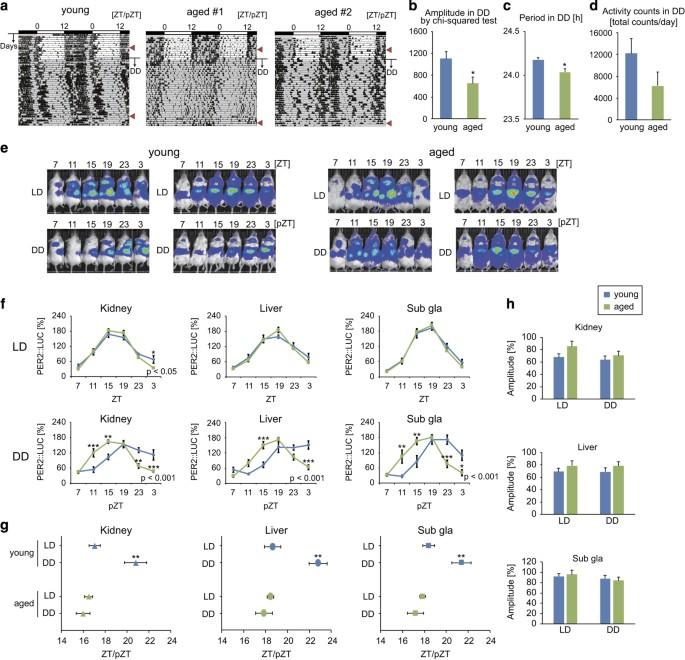Age-related circadian disorganization caused by sympathetic dysfunction in peripheral clock regulation
IF 4.1
Q2 GERIATRICS & GERONTOLOGY
引用次数: 54
Abstract
The ability of the circadian clock to adapt to environmental changes is critical for maintaining homeostasis, preventing disease, and limiting the detrimental effects of aging. To date, little is known about age-related changes in the entrainment of peripheral clocks to external cues. We therefore evaluated the ability of the peripheral clocks of the kidney, liver, and submandibular gland to be entrained by external stimuli including light, food, stress, and exercise in young versus aged mice using in vivo bioluminescence monitoring. Despite a decline in locomotor activity, peripheral clocks in aged mice exhibited normal oscillation amplitudes under light–dark, constant darkness, and simulated jet lag conditions, with some abnormal phase alterations. However, age-related impairments were observed in peripheral clock entrainment to stress and exercise stimuli. Conversely, age-related enhancements were observed in peripheral clock entrainment to food stimuli and in the display of food anticipatory behaviors. Finally, we evaluated the hypothesis that deficits in sympathetic input from the central clock located in the suprachiasmatic nucleus of the hypothalamus were in part responsible for age-related differences in the entrainment. Aged animals showed an attenuated entrainment response to noradrenergic stimulation as well as decreased adrenergic receptor mRNA expression in target peripheral organs. Taken together, the present findings indicate that age-related circadian disorganization in entrainment to light, stress, and exercise is due to sympathetic dysfunctions in peripheral organs, while meal timing produces effective entrainment of aged peripheral circadian clocks. Aging decreases day-night fluctuations of physiological functions in our body including sleep-wake cycle. Time-keeping mechanism of our clock is event of “entrainment” to daily environmental cues such as light-dark and food. Shigenobu Shibata from Waseda University in Japan and colleagues investigated a hallmark of age-related change of the circadian clock entrainment system by using non-invasive mouse peripheral clock imaging method. They found that weakened sympathetic regulations in aged animals attenuated internal clock information signaling between central and peripheral clocks, and caused the reduction of light-or exercise/stress-induced clock entrainment, but improved food-induced entrainment. Because circadian clock has an important role for homeostasis, investigating properties of entrainment ability will help us to find good medication strategy for age-related decline of physiological function.

外周时钟调节中交感神经功能障碍导致的与年龄有关的昼夜节律紊乱
昼夜节律钟适应环境变化的能力对于维持体内平衡、预防疾病和限制衰老的有害影响至关重要。迄今为止,人们对外周时钟对外界线索的相关变化知之甚少。因此,我们利用体内生物发光监测技术,评估了年轻小鼠和老年小鼠肾脏、肝脏和颌下腺的外周时钟受外界刺激(包括光、食物、压力和运动)影响的能力。尽管运动能力下降,但在光-暗、恒定黑暗和模拟时差条件下,老年小鼠的外周时钟表现出正常的振荡幅度,并有一些异常的相位变化。然而,在压力和运动刺激下,外周时钟的振荡出现了与年龄相关的损伤。相反,在外周时钟对食物刺激的诱导以及对食物的预期行为方面,却观察到了与年龄相关的增强。最后,我们评估了一个假设,即来自下丘脑上核中央时钟的交感神经输入的缺陷是造成与年龄相关的夹带差异的部分原因。老年动物对去甲肾上腺素能刺激的诱导反应减弱,肾上腺素能受体 mRNA 在目标外周器官的表达也减少。综上所述,本研究结果表明,与年龄相关的昼夜节律紊乱对光线、压力和运动的诱导是由于外周器官交感神经功能失调造成的,而进餐时间能有效诱导老年外周昼夜节律钟。衰老会降低人体生理功能的昼夜波动,包括睡眠-觉醒周期。我们时钟的计时机制是对每日环境线索(如光-暗和食物)的 "诱导"。日本早稻田大学的 Shigenobu Shibata 及其同事利用非侵入性小鼠外周时钟成像方法,研究了昼夜节律时钟诱导系统与年龄有关的变化特征。他们发现,老龄动物交感神经调节功能减弱会削弱中枢时钟和外周时钟之间的内部时钟信息信号传递,并导致光照或运动/压力诱导的时钟诱导功能减弱,但食物诱导的时钟诱导功能得到改善。由于昼夜节律钟对体内平衡具有重要作用,因此研究昼夜节律钟的诱导能力特性将有助于我们找到治疗与年龄相关的生理功能衰退的良好药物策略。
本文章由计算机程序翻译,如有差异,请以英文原文为准。
求助全文
约1分钟内获得全文
求助全文

 求助内容:
求助内容: 应助结果提醒方式:
应助结果提醒方式:


